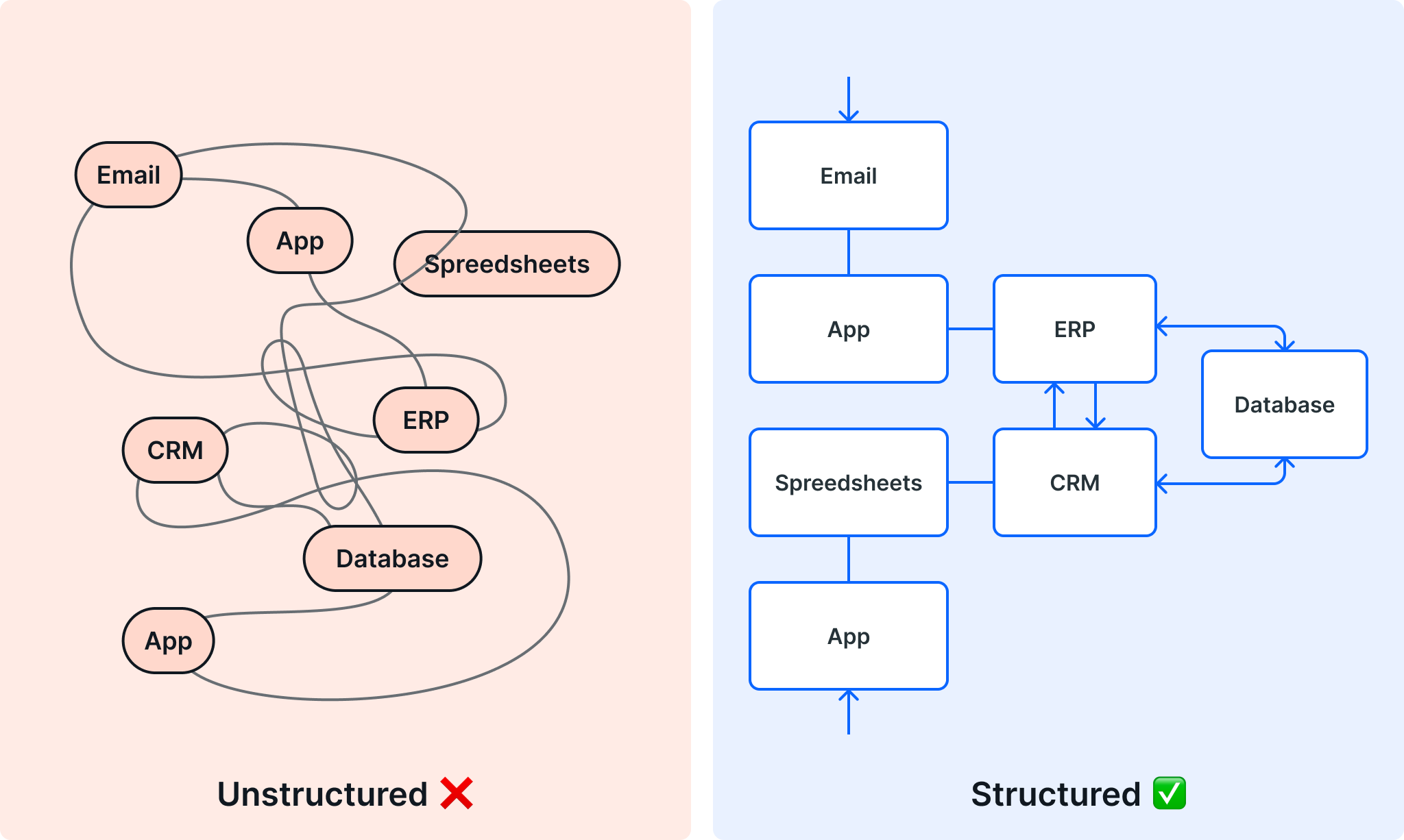
Business Process Management (BPM) refers to use of technology, strategy, and culture to achieve operational excellence and meet business objectives. The benefits of BPM are extensive for those who invest the time and effort necessary to optimize their process architecture. In this post, we’ll explore 10 of the most important benefits of BPM and why they matter.
Find the right automation tool for your BPM strategy with the Buyer’s Guide to Automation Platforms
Benefits of business process management (BPM)
The benefits of BPM are numerous and varied. What a company gains from implementing a BPM strategy will depend on the business type, size, complexity, and resources. Our research has shown that the following 10 benefits of BPM are the most common — and the most celebrated.
1 – Transforms complexity into cohesion
Businesses are composed of an array of processes, workflows, and systems. BPM brings the individual pieces of the overall process architecture into sharper focus. As a result, visibility and control over these processes improves. BPM addresses individual processes as well as the interdependency between them.
For example, the finance team has processes in place for a variety of tasks: accounts receivable, accounts payable, procurement, P2P, vendor selection, reimbursements, and others. BPM provides a framework for analyzing each of these processes on its own merit, then unifying and coordinating these processes to contain costs and improve collaboration.
2 – Prepares processes for automation
The traditional wisdom about automation goes something like this: automating an efficient process amplifies the efficiency; automating an inefficient process only exaggerates the inefficiency.
BPM gives teams the opportunity to optimize their processes by eliminating manual, repetitive, or redundant tasks. Once these processes are optimized, they are prime candidates for automation. Automation itself offers many benefits to the enterprise, including better SLA times, higher productivity, fewer errors, and increased customer satisfaction.
3 – Creates structured processes
Processes (and workflows) that lack structure produce inconsistent results. When individual team members or departments manage the same process in different ways, it becomes difficult — if not impossible — to enforce quality and security standards. Unstructured processes may lack accountability and managers may find it difficult to establish control.

BPM helps businesses avoid these problems by establishing process standardization. Inputs, steps, and outputs are defined and enforced, creating processes and workflows that are predictable and reliable. Most importantly, this helps the business establish structured processes.
4 – Makes processes scalable
Structured processes can be scaled. That is, successful elements can be replicated and increased control makes it possible to increase the volume of work that passes through the process. Think of a structured process as an equation made up of a series of fixed and variable elements: as the variable elements in the equation change, the output adjusts proportionately.
5 – Augments the existing stack
One of the most pressing challenges for many companies — and especially IT teams — is figuring out how to get more from the systems and apps in the existing stack. This is especially true any time teams are being asked to “do more with less.”
BPM isn’t just focused on the process structure — it’s also concerned with the technology that enables them. Within the BPM framework, an inventory and assessment of all systems, databases, apps, and other tools is taken. When process gaps are identified — such as when a new workflow can’t be automated or managed with the existing ERP or CRM, or when a data silo is uncovered — BPM gives teams an opportunity to resolve the issue with existing tools.
In many cases, low-code automation tools provide the flexible orchestration layer necessary to fill workflow gaps and manage any long tail processes. We refer to this as “stack extensibility.”
6 – Improves customer satisfaction
Customers feel the impact of business processes everyday. Whether it’s the time it takes to resolve a request, the consistency of the sales experience, or the accuracy of the accounts payable process, customers can tell the quality of one process from another. If there are silos in the process, chances are that the customer is feeling the impact of those silos, either through delays, poor follow ups, or the quality of their customer service experience.
BPM improves CSAT by building processes that produce timely, accurate, and consistent results.
7 – Supports security and compliance efforts
BPM addresses all the components of a business process: people, tasks, technology, and data. By unifying these components, BPM makes it easier to identify security threats such as data leaks and shadow IT. And because BPM helps businesses standardize their processes, IT teams have an easier time enforcing security, governance, and compliance requirements.
8 – Dissolves silos
One of the most important benefits of BPM comes from its ability to eliminate silos. These may be data silos, in which information isn’t being shared between people or systems, or they may be collaboration silos in which different teams lack visibility into each other’s activities.
BPM is a holistic discipline that aims to harmonize and coordinate all the processes and workflows within the organization. By mapping and analyzing the various processes, BPM identifies silos and finds opportunities to resolve them.
9 – Enables operational excellence
Every company has a goal of achieving operational excellence. This means doing business as efficiently and effectively as possible, without wasting resources.
There are several different approaches to operational excellence, including the Shingo, Lean, Kaizen, and Six Sigma models. Each has its own set of priorities and distinct methods, but the end goals are similar.
BPM supports efforts to achieve operational excellence by bringing visibility and control to all types of business processes. The process mapping and analysis components of BPM are particularly aligned with operational excellence initiatives, but BPM’s emphasis on people, data, and technology also holds relevance.
10 – Drives efficiency and productivity
Finally, BPM plays a crucial role in helping organizations hit their efficiency and productivity targets. BPM initiatives prioritize measuring and monitoring processes in order to first establish baselines, then to improve upon them. In other words, BPM is a tool for establishing process excellence.
A typical BPM framework applies strategy, design, innovation, and optimization components to every process in the organization. This level of analysis and continuous improvement have a single purpose: do more — better — with less.
Achieving the benefits of BPM with the right software
Businesses have been using business process management strategies since the 1980s. Since then, BPM efforts have sometimes gone by other names including Total Quality Management and Business Process Reengineering. But no matter the name, the goal has always been the same: building better processes in order to achieve operational excellence and hit business targets.
BPM software has evolved over the years to support these efforts. Today, many businesses extract the benefits of BPM by relying on artificial intelligence and no-code automation. AI in process management refers to the use of artificial intelligence to enhance efficiency, analyze data, and make it easier for users to monitor and manage their processes.
No-code automation software, like Pipefy, combines the advantages of no-code development (speed, accessibility) with those of process automation (efficiency, accuracy, orchestration.)
No-code automation also helps businesses conserve their developer resources and empowers business users to become co-creators in their journey toward process excellence. Learn more with a free trial.






